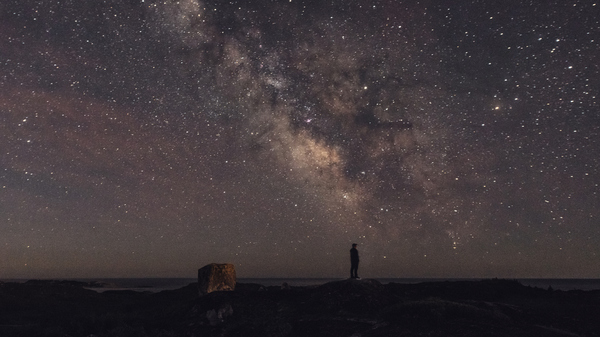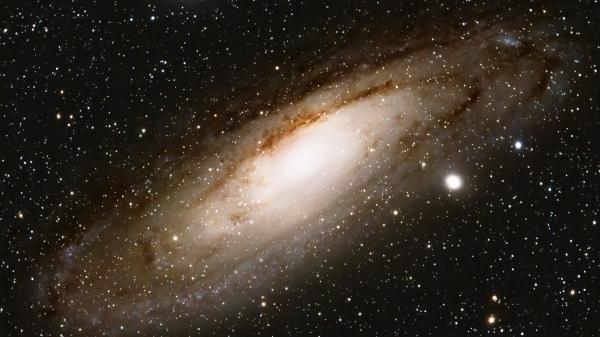Unwinding the Milky Way
Our galaxy is an enormous spiral of stars, planets, and gas surrounding what is thought to be a massive black hole.

In remote, dark places, the Milky Way can appear as a luminous ribbon of light.
©iStockphoto.com/shaunl
Getting a clear view of our home galaxy can be tricky. Light pollution keeps about one-third of people around the world (including 80% of Americans) from being able to see the Milky Way in the night sky.
But if you can escape strong sources of artificial light, you may be lucky enough to catch sight of our cosmic neighborhood as an ethereal cloud lighting up the darkness.
What’s visible in the night sky where you areHow to Spot the Glowing Band of Stars
The best way to scan for the Milky Way is to set up in a location with dark skies, then train your skywatching in the direction of the constellation of Sagittarius, which will mean you are looking toward the crowded galactic center.
Sagittarius sits between the constellations of Capricorn to the east and Scorpio to the west.
Find Sagittarius in your night sky
As you look towards Sagittarius A*, the assumed black hole in the dense middle of our galaxy, there is simply much more cosmic material; more stars, gas, and dust, for light to reflect on than in the further reaches of the Milky Way. So, if the conditions are right, this tightly-packed part of the cosmos will make an appearance as a hazy, illuminated arc stretching across the sky.
The best Milky Way viewing time depends on your position on the planet, but generally the ideal months are during summer in the Northern Hemiphere and winter in the Southern Hemisphere.
How to use the stars to tell time
The View from Space
If you could take in the view from far out in the deep darkness of space, our stellar neighborhood would reveal itself to be a huge spiral structure with two major arms and two lesser branches swirling out from a tightly-packed central band of stars.

Earth orbits about 26,000 light years from the assumed black hole at the galactic center.
©NASA/Adler/U.Chicago/Wesleyan/PL Caltech - (Earth placement by timeanddate)
How crowded is the middle of our galaxy? On Earth, a dark sky can display up to around 2000 stars. But if you lived on a planet in the dense central bulge of the galactic center, your night sky would be lit up by roughly 1 million more stars.
Where Earth Spins
Our planet is part of a solar system that rotates in one of the smaller galactic branches known as the Local Arm. Earth’s Sun is roughly two-thirds of the way out from what is probably a black hole at the core of the Milky Way, at a distance of about 26,000 light years from the galactic center.
The Largest Known Structures
As huge as it is, the Milky Way is not even one of the largest structures we know of. The biggest galaxies are more than a million light years across and contain trillions of stars, and even the smallest have thousands of stars and span hundreds of light years.
Zooming out, there are even larger cosmic structures called clusters that can contain thousands of galaxies. Groups of clusters can be arranged in superclusters, which can in turn form walls or sheets of galaxies. These superstructures are the largest known elements in the observable universe—stretching millions of light years across.
Galaxies are also some of the oldest structures in existence. Researchers believe the universe formed about 13.8 billion years ago, and the earliest galaxies seem to have formed close to the same time. Most are estimated to range between 10 billion and 13.6 billion years old.

Brace yourself for a collision with Andromeda (in a few billion years).
©iStockphoto.com/Manfred_Konrad
On a Collision Course
Closing in on the Milky Way, the Andromeda galaxy is set to crash into our part of the cosmos in about four billion years.
These collisions are not unusual in cosmic history. In fact, colliding galaxies are one of the most important drivers of star formation. In the Milky Way, fewer than two new stars are created every year, on average. But when galaxies collide and start to merge, close to 100 new solar masses are generated each year.
Scientists think that Andromeda has already collided and merged with other galaxies, which may explain why some of the stars in Andromeda’s outer regions, or its halo, are younger than similar stars in the Milky Way, even though both galaxies are the same age.

The James Webb Space Telescope is training infrared cameras on the center of the Milky Way.
©iStockphoto.com/alex-mit
Advanced Eyes in the Sky
Data sent back to Earth by the latest generation of space telescopes has been revealing more and more about the structure of galaxies in recent years.
The Webb Space Telescope uses infrared light-detection to get a better look at the very center of the Milky Way. This crowded region and the assumed black hole at its center, Sagittarius A*, may hold answers to some profound questions about the origin of our universe.
Scientists hope to use these new data streams to help answer questions about what formed first: galaxies or black holes? Or whether they both developed at the same time.